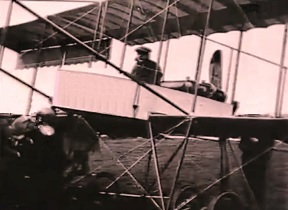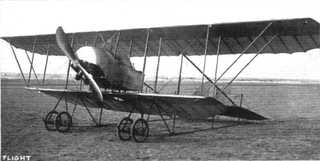
The Avro Type E, Type 500, and Type 502 made up a family of early British military aircraft, regarded by Alliott Verdon Roe as his firm's first truly successful design. It was a forerunner of the Avro 504, one of the outstanding aircraft of the First World War.

The Vickers Type 253 was a single-engined two-seat biplane general-purpose military machine built to a 1930 government specification. It won a production contract, but this was transferred to the same company's monoplane equivalent, the Wellesley. Only one Type 253 was built.

The Handley Page Type E was a two-seat, single-engined monoplane intended as a demonstrator. Though only one was built, it flew successfully from 1912 to 1914, carrying several hundred passengers and flying several thousand miles.

The Royal Aircraft Factory R.E.1 was an experimental two-seat single-engined biplane from before World War I, intended to develop reconnaissance aircraft.
The Perry Beadle T.1 was a single-seat, single engine biplane built and flown in the United Kingdom in 1913. In 1914 it flew with a more powerful engine and other modifications as the Perry Beadle T.2, which was acquired by the Royal Navy Air Service at the outbreak of World War I.

The Farman FF 65 Sport was a French built light biplane, with a single engine and tandem seats, intended for sport and touring. First flown in 1919, it achieved modest sales at home and abroad in the early 1920s. Two unusual modifications produced a biplane glider and a low aspect ratio parasol wing machine.

The Koolhoven Heidevogel was one of the first Dutch aircraft, an improvement of the popular Farman type.

The LFG Roland D.XV was a World War I German single seat fighter aircraft, ordered as a test-bed for engine comparisons. It was distinguished from earlier Roland biplane designs by the elimination of flying wires. Two later aircraft, also called LFG Roland D.XV, were completely different designs with slab sided fuselages.

The LFG Roland G.I was a large prototype single-engine biplane bomber built in Germany in 1915, during World War I. It had a single engine buried in the fuselage driving pusher configuration propellers mounted on outriggers.

The Caudron Type A was the first successful aircraft built by René Caudron and his brother Gaston. During 1910 the Caudron brothers were briefly associated with the Société Anonyme Français d'Aviation (S.A.F.A.), and an example of the type was exhibited at the 1910 Paris Aero Salon as the S.A.F.A. Biplane.
The Gerner G.I or Gerner G I, was a small, low powered, two seat biplane of steel tube construction, built in Germany in 1928. Only one was produced but the design led to the more successful Gerner G II R.

The Caudron C.74 was a ten-seat, four engine passenger biplane built in France in 1922. It showed promise but the sole prototype crashed fatally in a competition and no more were completed.

The Caudron C.68 was a two-seat French training and touring aircraft, built in the early 1920s, which attracted interest at the time because of its simple and fast wing folding arrangement. Only a few were produced.

The Caudron C.67 was a simple single seat biplane with a low powered engine. It was built and flown in France in 1922.

The Caudron Type O was a French single seat air racing biplane first flown in 1914.
The Caudron Type B was a 1911 development of the earliest Caudron type, the Caudron Type A, with a nacelle style fuselage and more powerful engine. Initially an equal span biplane, it was modified into a sesquiplane.
The Caudron Type B Multiplace was a large French biplane designed to carry up to five passengers in a cross-country time trial of 1912. It was destroyed early in the event.
The Caudron Type C was a single seat French biplane, intended for military evaluation. Two were built in 1911.

The Caudron Type F was a French single seat biplane produced just before World War I. A dozen were bought by China and at least two other examples, with different engines, competed in 1913, coming first and second in the biplane category of the cross-country race at Reims. Flown by Pierre Chanteloup, one was the first biplane to loop-the-loop.

The Caudron Type D was a French pre-World War I single seat, twin-boom tractor biplane, a close but slightly smaller relative of the two seat Caudron Type C. More than a dozen were completed, one exported to the United Kingdom, where they may also have been licence built, and three to China.

















